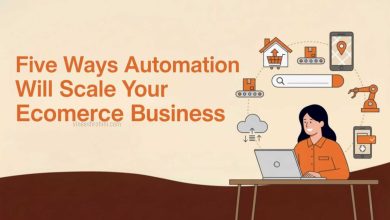How to Scale Your Online Business Quickly : Comprehensive Guide 2025
Scale Your Online Business : Scaling an online business is every entrepreneur’s dream—but it’s also one of the most challenging phases of the digital business journey. In 2025, with global competition, rapid technological advancements, and ever-evolving consumer behaviors, the need to scale smart, fast, and efficiently is more important than ever. Whether you’re running an e-commerce store, a SaaS platform, a freelance service, or a content-based business, understanding how to strategically grow your operations without sacrificing quality or customer experience is critical.
Table of Contents
This comprehensive guide will walk you through proven strategies, best practices, and essential tools to help you scale your online business quickly and sustainably in 2025.

Understanding the Concept of Scaling
Scaling isn’t just about growing in size. It’s about growing efficiently. It means increasing revenue without a corresponding increase in costs. A scalable business is one that can handle a growing amount of work or sales in a capable and cost-effective manner.
For example, if you make ₹1 lakh per month from your online store and spend ₹60,000 to earn that, scaling should help you make ₹10 lakh while spending just ₹2-3 lakh—not ₹6 lakh. This is the core idea of sustainable and scalable growth.
High-Potential Online Business Models to Scale in 2025
Before diving into scaling tactics, it’s important to understand if your business model is scalable. Here are a few high-potential models for 2025:
- Dropshipping
- Print-on-Demand
- Affiliate Marketing
- SaaS (Software as a Service)
- Digital Product Sales (Ebooks, Courses, Templates)
- E-commerce (Private Label or White Label)
- Online Services & Freelancing Agencies
Also Read : Selling via Livestream Shopping – How to Get Started ?
Each model has its own path to scaling, but the core principles remain largely the same.
Step 1: Strengthen the Foundation Before Scaling
1.1 Build a Solid Product/Market Fit
Before scaling, ensure your product or service solves a real problem and has a defined audience. Scaling without product-market fit leads to wasted resources and churn.
1.2 Streamline Operations
Use automation tools to manage inventory, emails, customer support, and finances. For example, tools like Zapier, HubSpot, Freshdesk, or Zoho CRM can handle repetitive tasks efficiently.
1.3 Upgrade Your Website Infrastructure
Ensure your website loads fast, has minimal downtime, and is mobile-optimized. Use CDN services like Cloudflare and choose high-performance hosting platforms like Kinsta, Hostinger, or Bluehost Pro for your e-commerce or service websites.
Step 2: Optimize for High Conversions
2.1 Improve Your Sales Funnel
From landing pages to checkout, every step should be optimized. Use heatmaps and A/B testing (tools like Hotjar or Optimizely) to analyze and tweak your funnel.
2.2 Leverage Conversion Rate Optimization (CRO)
Simple changes like better CTA placement, adding urgency (limited-time offers), or improving product descriptions can dramatically boost sales.
2.3 Use Exit-Intent Popups & Abandoned Cart Recovery
These tactics help retain customers who are on the verge of leaving your site. Shopify, WooCommerce, and even WordPress plugins like OptinMonster can automate this.
Step 3: Invest in Paid Advertising and Retargeting
3.1 Use Performance Marketing
Facebook Ads, Google Ads, YouTube Ads, and TikTok Ads are powerful for reaching large audiences fast. Focus on ROAS (Return on Ad Spend) instead of just clicks or impressions.
3.2 Scale Winning Campaigns
Start with a small budget, test creatives, and scale the ones with the highest ROI. Use platforms like Meta Ads Manager or Google Ads Smart Campaigns.
3.3 Master Retargeting
Use Facebook Pixel or Google Tag Manager to retarget users who visited but didn’t convert. Retargeting ads have higher conversion rates and lower costs.
Step 4: Expand Your Traffic Sources
4.1 SEO for Long-Term Growth
Invest in content marketing and SEO to attract organic traffic. Use tools like Ahrefs, SEMrush, or Ubersuggest to find high-volume, low-competition keywords.
4.2 Collaborate with Influencers
Influencer marketing—especially micro-influencers—works wonders for niche audiences. Use platforms like Collabstr, Upfluence, or direct outreach via Instagram or LinkedIn.
4.3 Grow an Email List
Offer free resources or discounts in exchange for emails. Use email marketing platforms like Mailchimp, Moosend, or ConvertKit to nurture leads and drive repeat business.
Step 5: Automate and Delegate

5.1 Hire Virtual Assistants and Freelancers
As you scale, offload tasks like customer service, data entry, or social media to freelancers. Use platforms like Fiverr, Upwork, or OnlineJobs.ph.
5.2 Automate Repetitive Tasks
Use automation tools like Zapier or Integromat to connect apps and automate workflows (e.g., sending receipts, follow-ups, reminders).
5.3 Systematize Your Business
Create SOPs (Standard Operating Procedures) for every task—from customer onboarding to refund processing. This makes delegation easier and ensures consistency.
Step 6: Offer New Products or Services
6.1 Upsell and Cross-Sell
Once you have a loyal customer base, introduce complementary products or services. Example: If you sell a camera, upsell a cleaning kit or tripod.
6.2 Launch Premium Versions
Offer a “Pro” or “VIP” version of your service or product to increase the average order value (AOV).
6.3 Test and Validate New Offers
Use pre-launch waitlists or limited-time betas to validate demand before investing heavily in product development.
Step 7: Build Brand Authority
7.1 Publish Case Studies and Testimonials
Social proof plays a massive role in conversions. Share customer success stories and reviews across your platforms.
7.2 Start a YouTube Channel or Podcast
Video and audio content build trust and authority. It also helps you repurpose content across platforms like Instagram, LinkedIn, and Facebook.
7.3 Appear on Other Platforms
Get featured in blogs, podcasts, or YouTube channels. PR and guest content help with SEO and brand credibility.
Step 8: Analyze, Measure & Improve
8.1 Track KPIs (Key Performance Indicators)
Important metrics include:
- Customer Acquisition Cost (CAC)
- Customer Lifetime Value (CLTV)
- Conversion Rate
- Cart Abandonment Rate
- Average Order Value (AOV)
8.2 Use Analytics Tools
Integrate Google Analytics 4, Facebook Pixel, and Shopify/WooCommerce dashboards to make data-backed decisions.
8.3 Regularly Audit Your Marketing Strategy
Don’t set and forget. Review campaign performance weekly, identify leaks in the funnel, and adjust based on real-time feedback.
Bonus Tips to Scale Fast in 2025
- Leverage AI: Use AI tools like ChatGPT for customer support, content writing, and product research.
- Subscription Models: Add recurring revenue streams to stabilize income.
- International Expansion: Go beyond local markets using global shipping solutions and multilingual websites.
- Cloud Scalability: Host your site on cloud platforms like AWS or DigitalOcean to handle traffic spikes.
Real-Life Case Study Example
Startup Name: Blendify Co. – Digital Art Print Store
Initial Setup: A digital store selling printable wall art on Etsy and Shopify.
Scaling Strategy:
- Automated email sequences using Klaviyo.
- Pinterest SEO for organic reach.
- Partnered with influencers in the home décor niche.
- Used Shopify’s cross-sell apps to increase AOV.
Result: Revenue grew from ₹80,000/month to ₹6,00,000/month in under 12 months without increasing the product count—just through optimization and automation.
Common Mistakes to Avoid While Scaling
- Scaling before establishing product-market fit.
- Spending too much on ads without testing creatives.
- Neglecting customer support while expanding.
- Failing to reinvest profits into growth.
- Ignoring backend systems like inventory and logistics.
Scale Your Online Business – Conclusion

Scaling your online business quickly in 2025 is highly achievable—if done strategically. Focus on building a strong foundation, automating operations, investing in high-converting marketing, and creating systems that allow you to grow without burning out. Diversify your traffic sources, reinvest intelligently, and keep your customer experience at the center of every decision.
Buy Now : Ecommerce Website
In the digital economy of 2025, agility, automation, and audience trust will be the biggest competitive advantages. Start now, scale smart, and go big.
Disclaimer : This content is for informational purposes only and does not constitute business, legal, or financial advice. Always consult with a certified professional before making significant decisions related to your business growth and investment.
Keywords : Scale Your Online Business – Scale Your Online Business 2025 – Scale Your Online Business Guide



